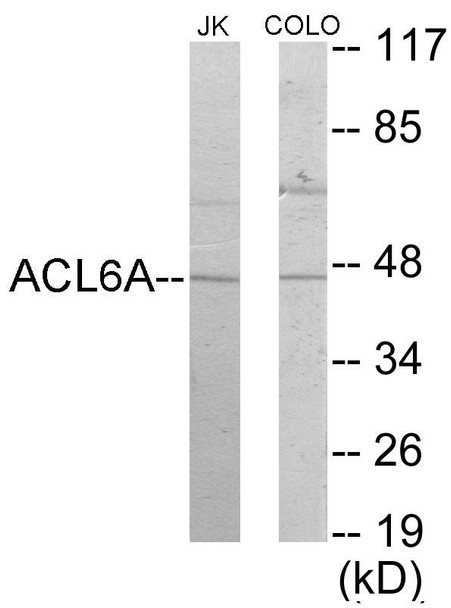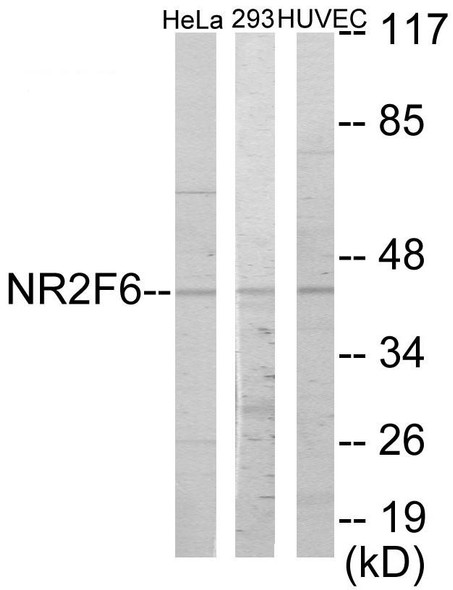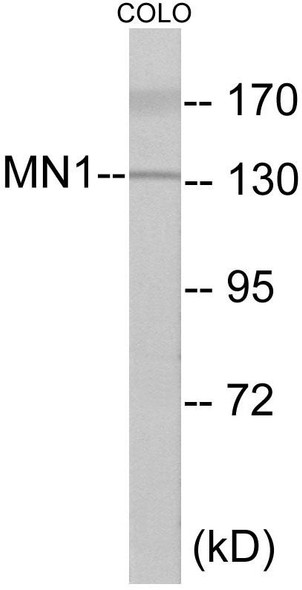ACTL6A Colorimetric Cell-Based ELISA (CBCAB00969)
- SKU:
- CBCAB00969
- Product Type:
- ELISA Kit
- ELISA Type:
- Cell Based
- Research Area:
- Epigenetics and Nuclear Signaling
- Reactivity:
- Human
- Mouse
- Rat
- Detection Method:
- Colorimetric
Description
ACTL6A Colorimetric Cell-Based ELISA
The ACTL6A Colorimetric Cell-Based ELISA Kit is a powerful tool for detecting and quantifying ACTL6A levels in cell lysates and tissue samples. This kit offers high sensitivity and specificity, providing accurate and reproducible results for research applications.ACTL6A is a key component of chromatin remodeling complexes and plays a critical role in gene expression regulation. Dysregulation of ACTL6A has been implicated in various diseases, including cancer and developmental disorders, making it an important target for further study and potential therapeutic interventions.
With the ACTL6A Colorimetric Cell-Based ELISA Kit, researchers can confidently analyze ACTL6A levels, gaining valuable insights into its role in cellular processes and disease pathology. This kit is easy to use and provides reliable data, making it an essential tool for advancing scientific research in the field of chromatin biology.
| Product Name: | ACTL6A Colorimetric Cell-Based ELISA |
| Product Code: | CBCAB00969 |
| ELISA Type: | Cell-Based |
| Target: | ACTL6A |
| Reactivity: | Human, Mouse, Rat |
| Dynamic Range: | > 5000 Cells |
| Detection Method: | Colorimetric 450 nmStorage/Stability:4°C/6 Months |
| Format: | 96-Well Microplate |
The ACTL6A Colorimetric Cell-Based ELISA Kit is a convenient, lysate-free, high throughput and sensitive assay kit that can detect ACTL6A protein expression profile in cells. The kit can be used for measuring the relative amounts of ACTL6A in cultured cells as well as screening for the effects that various treatments, inhibitors (ie siRNA or chemicals), or activators have on ACTL6A.
Qualitative determination of ACTL6A concentration is achieved by an indirect ELISA format. In essence, ACTL6A is captured by ACTL6A-specific primary antibodies while the HRP-conjugated secondary antibodies bind the Fc region of the primary antibody. Through this binding, the HRP enzyme conjugated to the secondary antibody can catalyze a colorimetric reaction upon substrate addition. Due to the qualitative nature of the Cell-Based ELISA, multiple normalization methods are needed:
| 1. | A monoclonal antibody specific for human GAPDH is included to serve as an internal positive control in normalizing the target absorbance values. |
| 2. | Following the colorimetric measurement of HRP activity via substrate addition, the Crystal Violet whole-cell staining method may be used to determine cell density. After staining, the results can be analysed by normalizing the absorbance values to cell amounts, by which the plating difference can be adjusted. |
| Database Information: | Gene ID: 86, UniProt ID: O96019, OMIM: 604958, Unigene: Hs.435326 |
| Gene Symbol: | ACTL6A |
| Sub Type: | None |
| UniProt Protein Function: | BAF53A: an actin-related protein involved in transcriptional activation and repression of select genes by chromatin remodeling (alteration of DNA-nucleosome topology). Required for maximal ATPase activity of the helicase SMARCA4 and for association of the SMARCA4 containing remodelling complex BAF with chromatin/nuclear matrix. A component of the NuA4 histone acetyltransferase (HAT) complex which is involved in transcriptional activation of specific genes. Two alternatively spliced human isoforms have been described. |
| UniProt Protein Details: | Chromosomal Location of Human Ortholog: 3q26.33 Cellular Component: NuA4 histone acetyltransferase complex; nuclear chromatin; nucleoplasm; nucleus; plasma membrane; protein complex; SWI/SNF complex Molecular Function:chromatin binding; nucleosomal DNA binding; protein binding Biological Process: ATP-dependent chromatin remodeling; chromatin remodeling; signal transduction |
| NCBI Summary: | This gene encodes a family member of actin-related proteins (ARPs), which share significant amino acid sequence identity to conventional actins. Both actins and ARPs have an actin fold, which is an ATP-binding cleft, as a common feature. The ARPs are involved in diverse cellular processes, including vesicular transport, spindle orientation, nuclear migration and chromatin remodeling. This gene encodes a 53 kDa subunit protein of the BAF (BRG1/brm-associated factor) complex in mammals, which is functionally related to SWI/SNF complex in S. cerevisiae and Drosophila; the latter is thought to facilitate transcriptional activation of specific genes by antagonizing chromatin-mediated transcriptional repression. Together with beta-actin, it is required for maximal ATPase activity of BRG1, and for the association of the BAF complex with chromatin/matrix. Three transcript variants that encode two different protein isoforms have been described. [provided by RefSeq, Jul 2008] |
| UniProt Code: | O96019 |
| NCBI GenInfo Identifier: | 23396463 |
| NCBI Gene ID: | 86 |
| NCBI Accession: | O96019.1 |
| UniProt Secondary Accession: | O96019,Q8TAE5, Q9BVS8, Q9H0W6, B3KMN1, D3DNR9, |
| UniProt Related Accession: | O96019 |
| Molecular Weight: | 43,236 Da |
| NCBI Full Name: | Actin-like protein 6A |
| NCBI Synonym Full Names: | actin like 6A |
| NCBI Official Symbol: | ACTL6A |
| NCBI Official Synonym Symbols: | Arp4; ACTL6; BAF53A; INO80K; ARPN-BETA |
| NCBI Protein Information: | actin-like protein 6A |
| UniProt Protein Name: | Actin-like protein 6A |
| UniProt Synonym Protein Names: | 53 kDa BRG1-associated factor A; Actin-related protein Baf53a; ArpNbeta; BRG1-associated factor 53A; BAF53A; INO80 complex subunit K |
| Protein Family: | Actin-like protein |
| UniProt Gene Name: | ACTL6A |
| UniProt Entry Name: | ACL6A_HUMAN |
| Component | Quantity |
| 96-Well Cell Culture Clear-Bottom Microplate | 2 plates |
| 10X TBS | 24 mL |
| Quenching Buffer | 24 mL |
| Blocking Buffer | 50 mL |
| 15X Wash Buffer | 50 mL |
| Primary Antibody Diluent | 12 mL |
| 100x Anti-Phospho Target Antibody | 60 µL |
| 100x Anti-Target Antibody | 60 µL |
| Anti-GAPDH Antibody | 60 µL |
| HRP-Conjugated Anti-Rabbit IgG Antibody | 12 mL |
| HRP-Conjugated Anti-Mouse IgG Antibody | 12 mL |
| SDS Solution | 12 mL |
| Stop Solution | 24 mL |
| Ready-to-Use Substrate | 12 mL |
| Crystal Violet Solution | 12 mL |
| Adhesive Plate Seals | 2 seals |
The following materials and/or equipment are NOT provided in this kit but are necessary to successfully conduct the experiment:
- Microplate reader able to measure absorbance at 450 nm and/or 595 nm for Crystal Violet Cell Staining (Optional)
- Micropipettes with capability of measuring volumes ranging from 1 µL to 1 ml
- 37% formaldehyde (Sigma Cat# F-8775) or formaldehyde from other sources
- Squirt bottle, manifold dispenser, multichannel pipette reservoir or automated microplate washer
- Graph paper or computer software capable of generating or displaying logarithmic functions
- Absorbent papers or vacuum aspirator
- Test tubes or microfuge tubes capable of storing ≥1 ml
- Poly-L-Lysine (Sigma Cat# P4832 for suspension cells)
- Orbital shaker (optional)
- Deionized or sterile water
*Note: Protocols are specific to each batch/lot. For the correct instructions please follow the protocol included in your kit.
| Step | Procedure |
| 1. | Seed 200 µL of 20,000 adherent cells in culture medium in each well of a 96-well plate. The plates included in the kit are sterile and treated for cell culture. For suspension cells and loosely attached cells, coat the plates with 100 µL of 10 µg/ml Poly-L-Lysine (not included) to each well of a 96-well plate for 30 minutes at 37°C prior to adding cells. |
| 2. | Incubate the cells for overnight at 37°C, 5% CO2. |
| 3. | Treat the cells as desired. |
| 4. | Remove the cell culture medium and rinse with 200 µL of 1x TBS, twice. |
| 5. | Fix the cells by incubating with 100 µL of Fixing Solution for 20 minutes at room temperature. The 4% formaldehyde is used for adherent cells and 8% formaldehyde is used for suspension cells and loosely attached cells. |
| 6. | Remove the Fixing Solution and wash the plate 3 times with 200 µL 1x Wash Buffer for five minutes each time with gentle shaking on the orbital shaker. The plate can be stored at 4°C for a week. |
| 7. | Add 100 µL of Quenching Buffer and incubate for 20 minutes at room temperature. |
| 8. | Wash the plate 3 times with 1x Wash Buffer for 5 minutes each time. |
| 9. | Add 200 µL of Blocking Buffer and incubate for 1 hour at room temperature. |
| 10. | Wash 3 times with 200 µL of 1x Wash Buffer for 5 minutes each time. |
| 11. | Add 50 µL of 1x primary antibodies (Anti-ACTL6A Antibody and/or Anti-GAPDH Antibody) to the corresponding wells, cover with Parafilm and incubate for 16 hours (overnight) at 4°C. If the target expression is known to be high, incubate for 2 hours at room temperature. |
| 12. | Wash 3 times with 200 µL of 1x Wash Buffer for 5 minutes each time. |
| 13. | Add 50 µL of 1x secondary antibodies (HRP-Conjugated AntiRabbit IgG Antibody or HRP-Conjugated Anti-Mouse IgG Antibody) to corresponding wells and incubate for 1.5 hours at room temperature. |
| 14. | Wash 3 times with 200 µL of 1x Wash Buffer for 5 minutes each time. |
| 15. | Add 50 µL of Ready-to-Use Substrate to each well and incubate for 30 minutes at room temperature in the dark. |
| 16. | Add 50 µL of Stop Solution to each well and read OD at 450 nm immediately using the microplate reader. |
(Additional Crystal Violet staining may be performed if desired – details of this may be found in the kit technical manual.)






